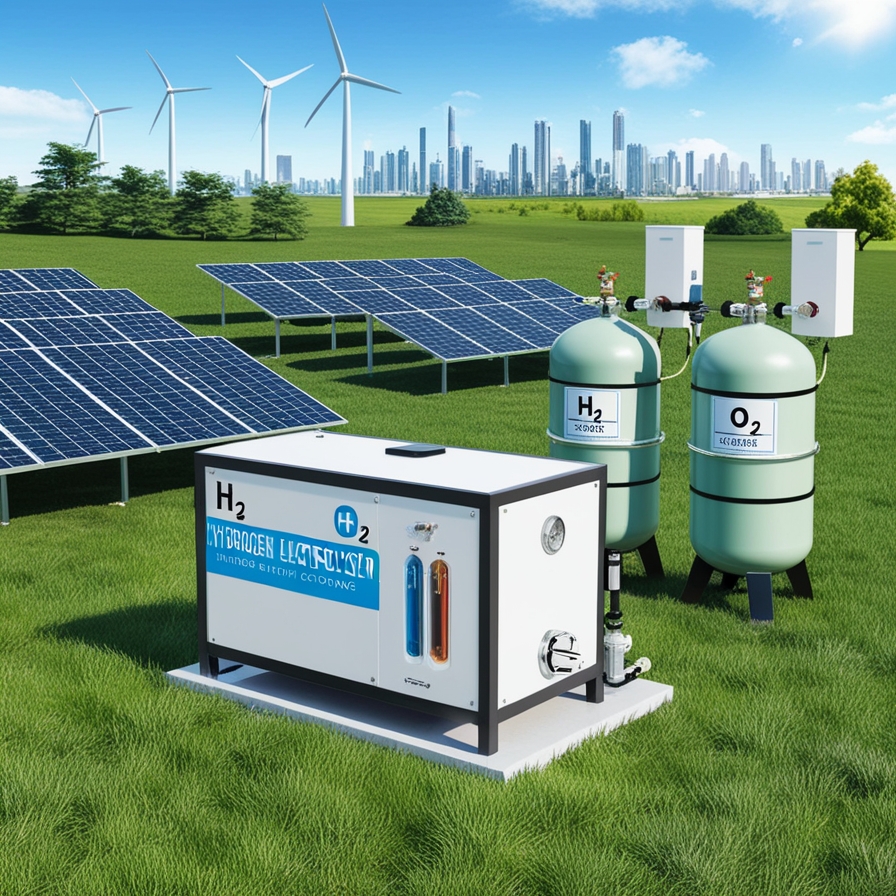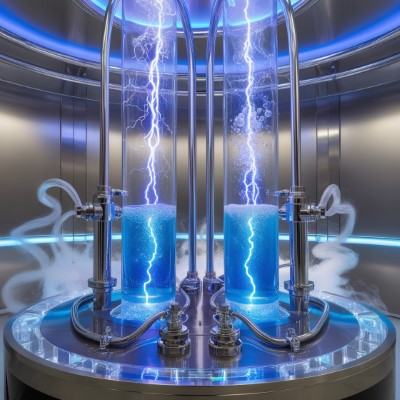What is an Electrolyser?
An electrolyser is a device that uses electricity to split water (H₂O) into hydrogen (H₂) and oxygen (O₂) through a process called electrolysis. Electrolysis is a crucial technology for producing green hydrogen, a clean energy carrier that plays a significant role in the transition to sustainable energy systems. Electrolysers are pivotal in various applications, including industrial processes, transportation, and energy storage, by providing a means to generate hydrogen without emitting carbon dioxide (CO₂).
How Does an Electrolyser Work?
Basic Principles
Electrolysis involves passing an electric current through water to cause a chemical reaction that separates the hydrogen and oxygen molecules. This process occurs within the electrolyser, which consists of two main components:
- Electrodes: Two electrodes (anode and cathode) are submerged in an electrolyte solution.
- Electrolyte: A conductive solution that facilitates the movement of ions.

Types of Electrolysers
There are three primary types of electrolysers, each differing in the type of electrolyte used and the specific processes:
- Alkaline Electrolyser:
- Electrolyte: Alkaline solution (e.g., potassium hydroxide, KOH).
- Operation: Hydrogen ions (H⁺) migrate to the cathode, where they gain electrons to form hydrogen gas (H₂). At the anode, water molecules lose electrons to form oxygen gas (O₂) and hydroxide ions (OH⁻).
- Efficiency: Typically ranges between 60-80%.
- Proton Exchange Membrane (PEM) Electrolyser:
- Electrolyte: Solid polymer membrane.
- Operation: Water is split at the anode to produce oxygen, protons (H⁺), and electrons. Protons pass through the membrane to the cathode, where they combine with electrons to form hydrogen gas.
- Efficiency: Typically ranges between 60-70%.
- Advantages: Higher current density, compact design, and rapid response to power fluctuations.
- Solid Oxide Electrolyser (SOE):
- Electrolyte: Ceramic material (e.g., yttria-stabilized zirconia, YSZ).
- Operation: At high temperatures (700-1000°C), water is split into hydrogen and oxygen ions. Oxygen ions migrate through the solid electrolyte to the anode, where they release electrons to form oxygen gas.
- Efficiency: Can exceed 80% due to high operating temperatures and better kinetics.
- Advantages: High efficiency and the ability to utilize heat from industrial processes.
Working Process
- Water Splitting: Water molecules are split into hydrogen and oxygen atoms at the respective electrodes.
- Ion Migration: Ions move through the electrolyte towards the electrodes.
- Gas Collection: Hydrogen gas is collected at the cathode, and oxygen gas is collected at the anode.
Challenges in Electrolyser Technology
Despite the promise of electrolysers for clean hydrogen production, several challenges need to be addressed to enhance their efficiency, durability, and economic viability.
Efficiency
- Energy Consumption: Electrolysis is energy-intensive. Improving the efficiency of the electrolytic process to reduce energy consumption is crucial.
- Catalyst Performance: Enhancing the performance of catalysts to reduce overpotentials and improve reaction kinetics is a key area of research.
Cost
- Material Costs: The use of expensive materials like platinum and iridium in PEM electrolysers increases costs.
- Manufacturing: Developing cost-effective manufacturing processes for electrolyser components is essential for widespread adoption.
Durability
- Degradation: Electrodes and membranes degrade over time, reducing the operational lifespan of electrolysers.
- Operating Conditions: High temperatures and corrosive environments can accelerate degradation, particularly in SOEs.
Scalability
- Integration: Integrating electrolysers with renewable energy sources and existing infrastructure presents technical and logistical challenges.
- Production Scale: Scaling up production while maintaining efficiency and cost-effectiveness is critical for meeting growing hydrogen demand.
Research Scope and Future Directions
Advanced Materials
- Catalysts: Research is focused on developing non-precious metal catalysts to reduce costs and improve durability.
- Membranes: Innovations in membrane materials aim to enhance ionic conductivity and mechanical stability.
System Integration
- Renewable Integration: Optimizing the integration of electrolysers with variable renewable energy sources like wind and solar to ensure stable hydrogen production.
- Hybrid Systems: Combining electrolysers with other energy systems, such as fuel cells and batteries, to enhance overall efficiency and flexibility.
Process Optimization
- High-Temperature Electrolysis: Exploring the potential of high-temperature electrolysis to leverage waste heat from industrial processes for improved efficiency.
- Pressure Electrolysis: Developing high-pressure electrolysers to produce hydrogen at higher pressures, reducing the need for subsequent compression.
Economic Models
- Cost Reduction Strategies: Investigating economic models and policy incentives to lower the overall cost of electrolyser systems.
- Supply Chain Optimization: Streamlining the supply chain for critical materials and components to enhance the economic feasibility of large-scale hydrogen production.
Conclusion
Electrolysers are at the forefront of the hydrogen economy, offering a pathway to sustainable and clean hydrogen production. While challenges related to efficiency, cost, durability, and scalability remain, ongoing research and technological advancements hold promise for overcoming these barriers. As the world increasingly turns towards renewable energy sources, electrolysers will play a pivotal role in shaping a sustainable energy future.
